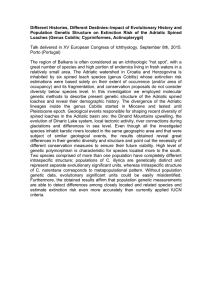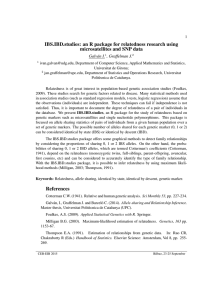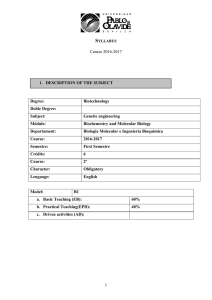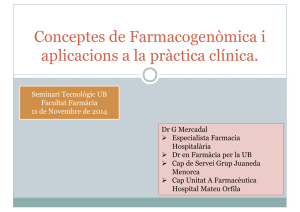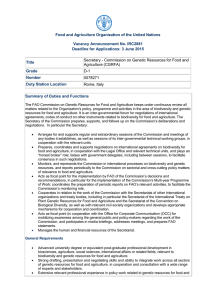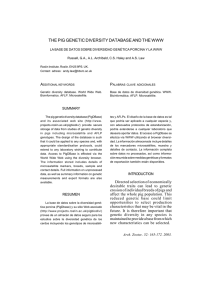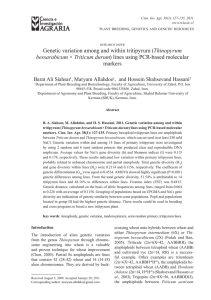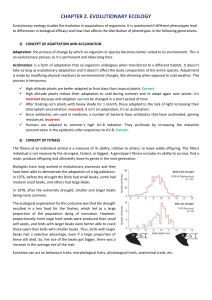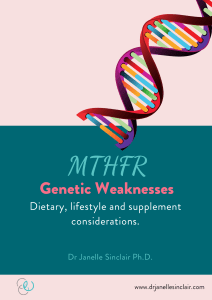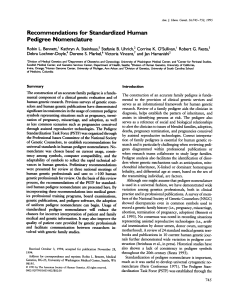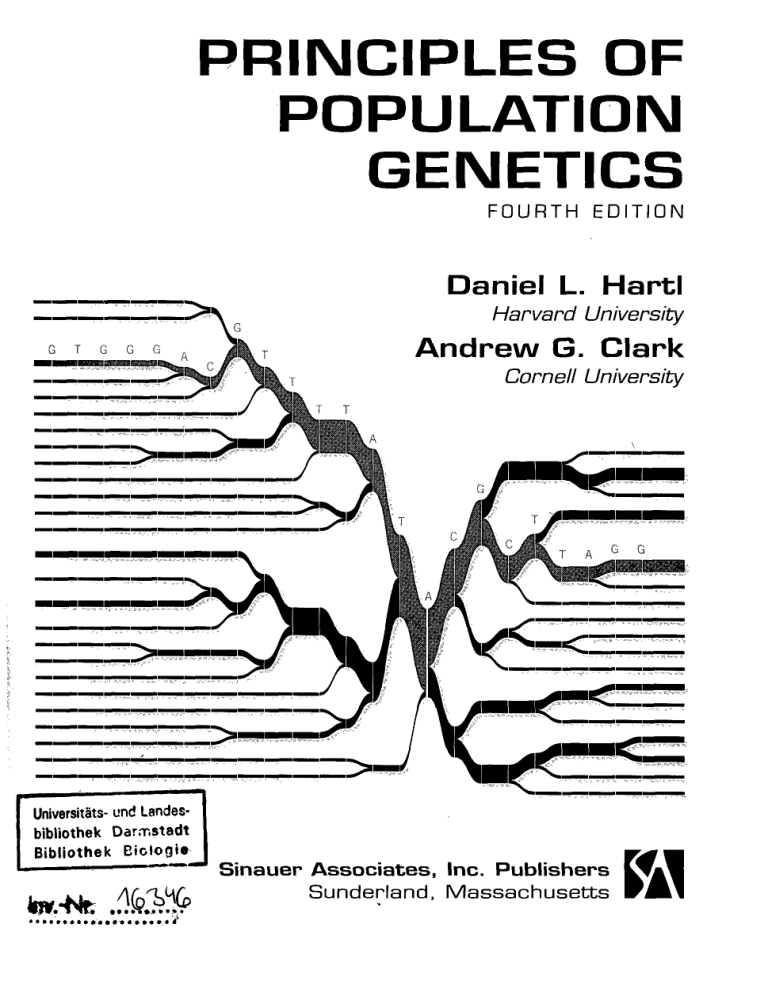
PRINCIPLES OF POPULATION GENETICS FOURTH EDITION Daniel L. Hartl Harvard University Andrew G. Clark Cornell University UniversitSts- und Landesbibliothek Darmstadt Bibliothek Biologie Sinauer Associates, Inc. Publishers Sunderland, Massachusetts TABLE OF CONTENTS PREFACE 1 xii GENETIC AND PHENOTYPIC VARIATION 1.1 RELEVANCE OF POPULATION GENETICS 1.2 PHENOTYPIC VARIATION IN NATURAL POPULATIONS 5 1.3 MULTIPLE-FACTOR INHERITANCE 1.4 MAINTENANCE OF GENETIC VARIATION 14 1.5 MOLECULAR POPULATION GENETICS Allele Frequencies and Genotype Frequencies 18 Polymorphism and Heterozygosity 20 Allozyme Polymorphisms 21 Inferences from Allozyme Polymorphisms 23 4 Continuous Variation: The Normal Distribution 5 Mean and Variance 6 The Central Limit Theorem 8 Discrete Mendelian Variation 10 3 1.6 POLYMORPHISMS IN DNA SEQUENCES 25 Restriction Enzymes 25 The Polymerase Chain Reaction 28 Single Nucleotide Polymorphisms 32 Synonymous and Nonsynonymous Polymorphisms 32 Segregating Sites and Nucleotide Mismatches 34 12 15 Electrophoresis 16 1.7 UTILITY OF GENETIC POLYMORPHISMS 38 Contents 2 2.1 ORGANIZATION OF GENETIC VARIATION RANDOM MATING 46 2.4 Nonoverlapping Generations 47 2.2 THE HARDY-WEINBERG PRINCIPLE 2.5 EXTENSIONS OF THE HARDY-WEINBERG PRINCIPLE 67 LINKAGE AND LINKAGE DISEQUILIBRIUM 7 3 Difficulties in Testing for Linkage Equilibrium 82 Relative Measures of Linkage Disequilibrium: D' and rs 83 2.3 TESTING FOR HARDY-WEINBERG EQUILIBRIUM 54 Difficulties in Testing for Hardy-Weinberg Equilibrium 54 Complications of Dominance 62 Frequency of Heterozygotes 66 45 Three or More Alleles 67 X-Linked Genes 70 48 Random Mating of Genotypes versus Random Union of Gametes 50 Implications of the Hardy-Weinberg Principle 52 vii 2.6 CAUSES OF LINKAGE DISEQUILIBRIUM 8 4 Linkage Disequilibrium Due to Population Admixture 85 Linkage Disequilibrium Due to Reduced Recombination 86 3 RANDOM GENETIC DRIFT 95 3.1 RANDOM GENETIC DRIFT AND BINOMIAL SAMPLING 95 3.2 THE WRIGHT-FISHER MODEL OF RANDOM GENETIC DRIFT 102 Unequal Sex Ratio, Sex Chromosomes, Organelle Genes 123 Variance in Offspring Number 126 Effective Size of a Subdivided Population 127 3.3 THE DIFFUSION APPROXIMATION 105 3.6 An Approach Looking Forward 106 An Approach Looking Backward 11O Absorption Time and Time to Fixation 112 3.4 RANDOM DRIFT IN A SUBDIVIDED POPULATION 113 3.5 EFFECTIVE POPULATION SIZE 3.7 THEORETICAL IMPLICATIONS OF COALESCENCE 138 Coalescent Models with Recombination 14O Linkage Disequilibrium Mapping 143 121 MUTATION AND THE NEUTRAL THEORY 4.1 MUTATION 151 Irreversible Mutation 152 Reversible Mutation 156 4.2 MUTATION AND RANDOM GENETIC DRIFT 158 Probability of Fixation of a New Neutral Mutation 160 128 Coalescent Effective Size 133 Coalescence with Population Growth 134 Coalescent Models with Mutation 136 Applications of Coalescent Methods 137 Fluctuation in Population Size 121 4 GENE TREES AND COALESCENCE 151 4.3 THE NEUTRAL THEORY OF MOLECULAR EVOLUTION 161 4.4 THE INFINITE-ALLELES MODEL 162 The Ewens Sampling Formula 166 The Ewens-Watterson Test 168 viii 4.5 Contents INFINITE-SITES MODEL 4.6 172 Nucleotide Polymorphism and Nucleotide Diversity 175 Tajima's D Statistic 176 The Fu and Li Test of Fit to Neutral Coalescence 178 5 5.1 199 5.5 Discrete Generations 2OO Continuous Time 204 Change in Allele Frequency in Haploids 205 Darwinian Fitness and Malthusian Fitness 206 5.2 SELECTION IN DIPLOID ORGANISMS EQUILIBRIA WITH SELECTION 206 215 Overdominance 216 Local Stability 220 Heterozygote Inferiority 222 Stable Equilibria with Multiple Alleles 223 Adaptive Topography and the Role of Random Genetic Drift 225 5.4 MUTATION-SELECTION BALANCE 6.1 5.6 INTERDEME SELECTION IN GEOGRAPHICALLY SUBDIVIDED POPULATIONS 245 5.7 SELECTION IN A FINITE POPULATION 226 Equilibrium Allele Frequencies 226 The Haldane-Muller Principle 228 6 MORE COMPLEX TYPES OF SELECTION 229 Differential Selection in the Sexes 229 X-Linked Genes 230 Frequency-Dependent Selection 230 Density-Dependent Selection 231 Fecundity Selection 231 Age-Structured Populations 232 Heterogenous Environments and Clines 232 Diversifying Selection 534 Gametic Selection 236 Meiotic Drive 236 Multiple Loci and Gene Interaction: Epistasis 239 Evolution of Recombination Rate 241 Sexual Selection 241 Kin Selection 243 Change in Allele Frequency in Diploids 208 Marginal Fitness and Selection with Multiple Alleles 212 Application to the Evolution of Insecticide Resistance 215 5.3 182 A Model for the Evolutionary Benefit of Recombination 183 Muller's Ratchet 185 Piecewise Recombination in Bacteria 187 Animal Mitochondrial DNA 189 DARWINIAN SELECTION SELECTION IN HAPLOID ORGANISMS 200 MUTATION AND RECOMBINATION 248 Weak Selection and the Nearly Neutral Theory 248 Genetic "Draft" 251 INBREEDING, POPULATION SUBDIVISION, AND MIGRATION 257 INBREEDING 257 The Inbreeding Coefficient 258 Genotype Frequencies with Inbreeding 259 Genetic Effects of Inbreeding 265 Calculation of the Inbreeding Coefficient from Pedigrees 268 Regular Systems of Mating 272 6.2 POPULATION SUBDIVISION 275 Reduction in Heterozygosity Due to Population Subdivision 276 Average Heterozygosity 278 Wright's F Statistics 281 Linanthus Revisited: Evidence for Selection Associated with Flower Color 285 Contents Inference of Population Structure from Multilocus Genotype Data 286 6.3 THE WAHLUND PRINCIPLE 288 Wahlund's Principle and the Fixation Index 291 • Genotype Frequencies in Subdivided Populations 291 Relation between the Inbreeding Coefficient and the F Statistics 293 7 6 . 4 ASSORTATIVE MATING 2 9 4 6.5 MIGRATION 2 9 5 One-Way Migration 295 The Island Model of Migration 297 How Migration Limits Genetic Divergence 299 Estimates of Migration Rates 303 Coalescence-Based Estimates of Migration 303 Migration-Selection Balance 307 MOLECULAR POPULATION GENETICS 7.1 THE NEUTRAL THEORY AND MOLECULAR EVOLUTION 3 1 8 Theoretical Principles of the Neutral Theory 318 7.2 ESTIMATING RATES OF MOLECULAR SEQUENCE DIVERGENCE 3 2 1 Rates of Amino Acid Replacement 322 Rates of Nucleotide Substitution 326 Statistical Fitting of Nucleotide Substitution Models 329 7.3 THE MOLECULAR CLOCK 329 Variation among Genes in the Rate of the Molecular Clock 332 Variation across Lineages in Clock Rate 334 The Generation-Time Effect 337 The Overdispersed Molecular Clock and the Neutral Theory 338 The Nearly Neutral Theory 339 7.4 PATTERNS OF NUCLEOTIDE AND AMINO ACID SUBSTITUTION 3 4 0 Calculating Synonymous and Nonsynonymous Substitution Rates 34O Codon Substitution Models 343 Observations of Synonymous and Nonsynonymous Substitution Rates 345 Polymorphism within Species 347 Implications of Codon Usage Bias 349 ix 317 7.5 POLYMORPHISM AND DIVERGENCE IN NUCLEOTIDE SEQUENCE— THE MCDONALD-KREITMAN AND HKA TESTS 3 5 1 Polymorphism and Divergence in Noncoding Sequences 354 Impact of Local Recombination Rates 354 Substitution Models for Structural RNA Genes 356 7.6 GENE GENEALOGIES 358 Hypothesis Testing Using Trees 358 7 . 7 MlTOCHONDRIAL AND CHLOROPLAST DNA EVOLUTION 362 Chloroplast DNA and Organelle Transmission in Plants 363 Maintenance of Variation in Organelle Genomes 364 Evidence for Selection in mtDNA 365 7.8 MOLECULAR PHYLOGENETICS 366 Algorithms for Phylogenetic Tree Reconstruction 366 Distance Methods versus Parsimony 369 Bootstrapping and Statistical Confidence in a Tree 370 Bayesian Methods 370 Trans-Species Polymorphism 371 7.9 MULTIGENE FAMILIES 3 7 2 Concerted Evolution 374 Subfunctionalization 375 Birth-and-Death Process 376 x 8 Contents EVOLUTIONARY QUANTITATIVE GENETICS 8.1 TYPES OF QUANTITATIVE TRAITS 387 8.2 RESEMBLANCE BETWEEN RELATIVES AND THE CONCEPT OF HERITABILITY 388 8.3 ARTIFICIAL SELECTION AND REALIZED HERITABILITY 394 Contribution of New Mutations to the Response to Selection 396 Prediction Equation for Individual Selection 397 Limits to Selection 400 8.4 GENETIC MODELS FOR QUANTITATIVE TRAITS 4 0 3 Change in Allele Frequency 412 Change in Mean Phenotype 413 Linearity of Response 415 8.5 COMPONENTS OF PHENOTYPIC VARIANCE 4 1 6 Genetic and Environmental Sources of Variation 416 Components of Genotypic Variation 422 8 . 6 COVARIANCE AMONG RELATIVES 4 2 6 Twin Studies and Inferences of Heritability in Humans 430 Estimation of Genetic Variance Components in Natural Populations 432 9 POPULATION GENOMICS 9.1 EVOLUTION OF GENOME SIZE AND COMPOSITION 4 7 0 Organismic Complexity and the C-Value . Paradox 470 Base Composition of Genomic DNA 471 9.2 GENOME-WIDE PATTERNS OF POLYMORPHISM 4 7 3 Excess Polymorphism in Subtelomeric Regions 473 Polymorphism and Rates of Recombination 475 Hitchhiking versus Background Selection 477 Linkage Disequilibrium and Haplotype Structures 481 385 8.7 NORM OF REACTION, THRESHOLD TRAITS, AND GENETIC CORRELATION 433 Norm of Reaction and Phenotypic Plasticity 433 Threshold Traits: Genes as Risk Factors in Disease 437 Genetic Correlation and Correlated Response 439 8.8 EVOLUTIONARY QUANTITATIVE GENETICS 4 4 3 Inference of Selection from Phenotypic Data 443 Evolution of Multiple Intercorrelated Traits 444 Random Genetic Drift and Phenotypic Evolution 446 Mutational Variance and MutationAccumulation Experiments 448 Mutation-Selection Balance for Quantitative Traits 449 8.9 GENES THAT AFFECT QUANTITATIVE TRAITS 4 5 2 The Number of Genes Affecting Quantitative Traits 453 Methods for Mapping QTLs 455 469 Decline of Linkage Disequilibrium with Genetic Distance 483 9.3 DIFFERENCES BETWEEN SPECIES 484 Comparison of Nonsynonymous and Synonymous Divergence 484 Positive Selection 486 Exploiting a Phylogenetic Signal 487 Polymorphism and Divergence 487 Compensated Pathogenic Deviations 489 Structure-Function Analysis 491 9.4 SEXUAL SELECTION AND THE SEX CHROMOSOMES 492 Faster-Male Molecular Evolution 493 Contents Molecular Evolution of Genes in the, X Chromosome 495 Haldane's Rule 495 Demasculinization of the X Chromosome 497 9.5 TRANSPOSABLE ELEMENTS Factors Controlling the Population Dynamics of Transposable Elements 5O1 Insertion Sequences and Composite Transposons in Bacteria 502 Transposable Elements in Eukaryotes 505 Population Dynamics of Transposable Elements 505 Nonuniformity of Transposition Rates 506 Horizontal Transmission of Transposable Elements 511 498 Diverse Types of Transposable Elements 498 10 10.1 HUMAN POPULATION GENETICS HUMAN POLYMORPHISM POPULATION GENETIC INFERENCES FROM HUMAN S N P S 524 10.5 Ascertainment Bias of SNP Genotypes 524 Departures from Hardy-Weinberg Frequencies 527 Site Frequency Spectrum and Human Population Growth 527 Rooting Human Polymorphism 529 Inference of Inhomogeneities in the Mutation Process 530 Inferences about Male and Female Mutation Rates 531 10.3 10.6 10.7 BIBLIOGRAPHY 597 567 GENETIC BASIS FOR VARIATION IN RISK OF COMPLEX DISEASE 550 SEEKING SIGNATURES OF HUMANSPECIFIC GENETIC ADAPTATIONS 554 Interspecific Divergence 554 McDonald-Kreitman and Poisson Random Field Tests 555 Local Distortions in Linkage Disequilibrium 556 FST Tests POPULATION STRUCTURE INFERRED FROM HUMAN POLYMORPHISM 539 ANSWERS TO CHAPTER-END PROBLEMS 547 Mutation-Selection Balance 548 Dating the Origin of Mutant Alleles 548 Mapping Methods Based on Linkage 55O Linkage Disequilibrium Mapping 552 Genome-Wide Association Studies 553 LINKAGE DISEQUILIBRIUM ACROSS THE HUMAN GENOME 532 Multilocus Methods of Inference of ' Stratification 540 Heterogeneity in Linkage Disequilibrium across Human Populations 542 MENDELIAN DISEASE AND POPULATION GENETICS ' The Landscape of Human Linkage Disequilibrium 532 Inferences about Local Rates of Recombination 537 10.4 519 Linkage Disequilibrium in Admixed Populations: Admixture Mapping 544 Inbred Populations and Homozygosity Mapping 544 520 Public SNP Resources and the HapMap Project 521 10.2 xi 557 Genome Scans for Selection-Skewed Site Frequency Spectrum 557 10.8 HUMAN ORIGINS 558 Neanderthal Genome Sequence 562 AUTHOR INDEX SUBJECT INDEX 629 635
